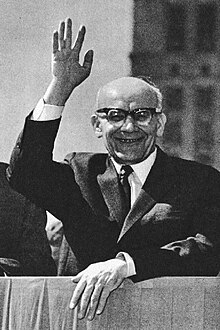User:Antoni12345/sandbox7
Ministry of Public Security (Poland)
| Ministerstwo Bezpieczeństwa Publicznego | |
 Coat of arms of the Polish People's Republic | |
| Agency overview | |
|---|---|
| Formed | 1 January 1945 |
| Dissolved | 7 December 1954 |
| Superseding agency | |
| Type | |
| Headquarters | Warsaw |
| Employees | 10,000 (1945)[1] |
| Minister responsible | |
| Child agencies | |
The Ministry of Public Security (Polish: Ministerstwo Bezpieczeństwa Publicznego, MBP) was a ministry and a secret police, security and intelligence agency of the Polish People's Republic during the Stalinist era, between 1944 and 1954. The ministry and its field offices were jointly commonly known as the Security Office (Urząd Bezpieczeństwa, UB).
The only minister was Stanisław Radkiewicz, remaining in office for 10 years.
Later replaced with the Ministry of Internal Affairs in 1954, and its Security Service in 1956.
First Secretary of PZPR
| First Secretary of the Central Committiee of the Polish United Workers' Party | |
|---|---|
 Party's logo | |
| Polish United Worker's Party | |
| Type | Party leader |
| Abbreviation | 1st secretary of KC PZPR |
| Member of | |
| Formation | 22 December 1948 (17 March 1954)[a] |
| First holder | Bolesław Bierut |
| Final holder | Mieczysław Rakowski |
| Abolished | 29 January 1990 |
The First Secretary of the Central Committiee of the Polish United Workers' Party[b] was the leader of the Polish United Workers' Party, the rulling communist party of the Polish People's Republic.
The office directly superseded the first secretary of the Polish Workers' Party, when it merged with the Polish Socialist Party on 22 December 1948. Initially established as the chairman of the Central Committiee of the Polish United Workers' Party,[c] the post was renamed on 17 March 1954 and lasted untill the dissolution of the PZPR on 29 January 1990.
While First Secretaries may or may not have held official state posts, they are regarded as de facto country leaders during the period of communist rule in Poland.
List
| Name (Birth–Death) |
Portrait | Took office | Left office | Term lenght | Portfolio[d] | |
|---|---|---|---|---|---|---|
| 1 | Bolesław Bierut (1892–1956) |

|
21 December 1948 | 12 March 1956 | 7 years, 83 days |
|
| 2 | Edward Ochab (1906–1989) |

|
20 March 1956 | 21 October 1956 | 216 days | None |
| 3 | Władysław Gomułka (1905–1982) |

|
21 October 1956 | 20 December 1970 | 14 years, 61 days |
|
| 4 | Edward Gierek (1913–2001) |

|
20 December 1970 | 6 September 1980 | 9 years, 261 days |
|
| 5 | Stanisław Kania (1927–2020) |

|
6 September 1980 | 18 October 1981 | 1 year, 43 days | None |
| 6 | Wojciech Jaruzelski (1923–2014) |

|
18 October 1981 | 29 July 1989 | 7 years, 285 days |
|
| 7 | Mieczysław Rakowski (1926–2008) |

|
29 July 1989 | 29 January 1990 | 185 days | None |
- Mołdawa, Tadeusz (1991). Ludzie władzy 1944-1991 (in Polish). Warsaw: Wydawnictwo Naukowe PWN. p. 260. ISBN 83-01-10386-8.
- ^ Untill 17 March 1954, the office was known as the Chairman of the Central Committiee of the Polish United Workers' Party (Polish: Przewodniczący Centralnego Komitetu Polskiej Zjednoczonej Partii Robotniczej, Przewodniczący KC PZPR).
- ^ Polish: Pierwszy sekretarz Komitetu Centralnego Polskiej Zjednoczonej Partii Robotniczej or I sekretarz KC PZPR
- ^ Polish: Przewodniczący Komitetu Centralnego Polskiej Zjednoczonej Partii Robotniczej, Przewodniczący KC PZPR
- ^ State offices held at the time of tenure.
Warsaw City Council
Jurisdiction
Warsaw is one of the cities with county rights (miasto na prawach powiatu), a municipality excercising authority and responsibilities of a county (powiat). Thus the Warsaw City Council decides with county and municipal matters within a geographical area of the capital.
Main roles of the Council are to supervise the Mayor and provide local legislature, including:
- plan zagospod
Constituencies and election
Members of the council are elected in multi-member constituencies with the party-list proportional representation using D'Hondt apportionment method.
There are currently ten constituencies (since the 2024 election) comprising Warsaw districts:
| Constituency number | Districts | Seats |
|---|---|---|
| 1 | Śródmieście, Ochota | 6 |
| 2 | Praga South | 6 |
| 3 | Mokotów | 7 |
| 4 | Wola | 5 |
| 5 | Bielany, Żoliborz | 6 |
| 6 | Białołęka | 5 |
| 7 | Rembertów, Wawer, Wesoła | 5 |
| 8 | Ursynów, Wilanów, Włochy | 8 |
| 9 | Bemowo, Ursus | 6 |
| 10 | Targówek, Praga North | 6 |
Ordynacja see more Local elections in Poland#Municipal councils
- ^ Piotrowski, Tadeusz (December 10, 1998). Poland's Holocaust: Ethnic Strife, Collaboration with Occupying Forces and Genocide in the Second Republic, 1918-1947. McFarland. ISBN 9780786403714 – via Google Books.

